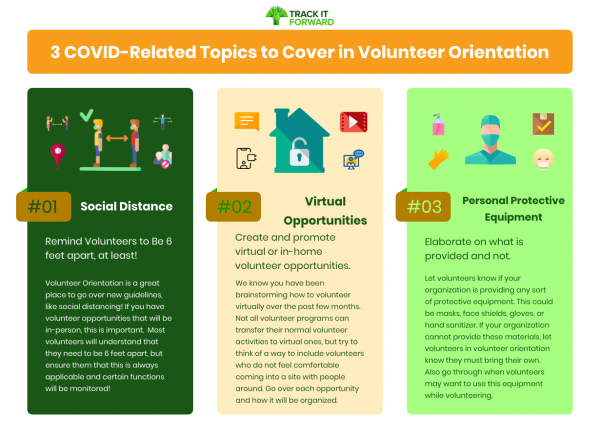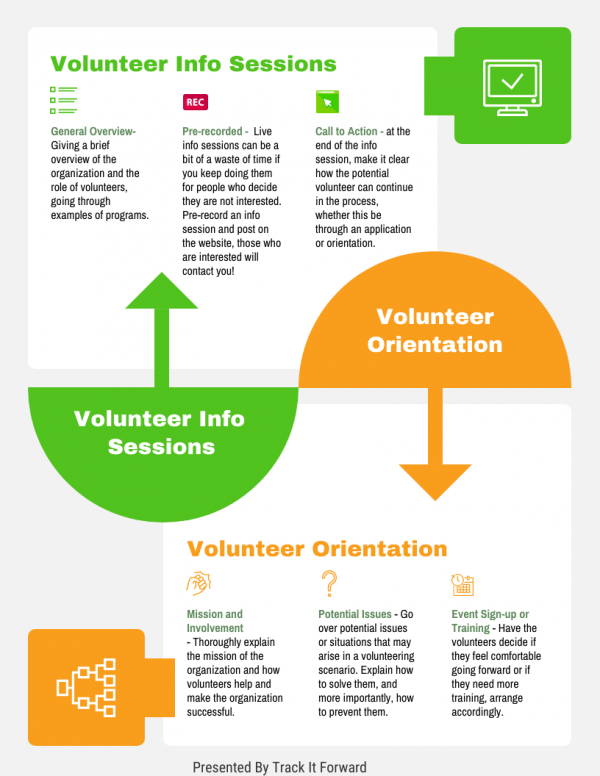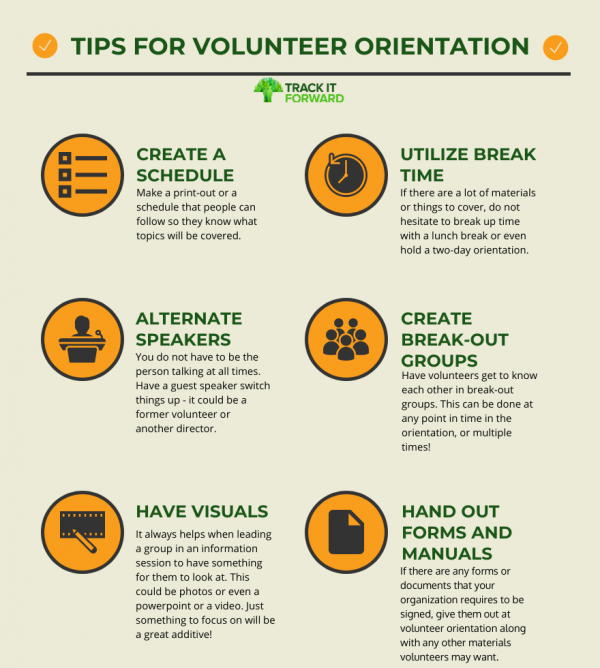Volunteer orientation is the first opportunity for your organization to showcase how special volunteer work is to the organization. It is also the first impression a volunteer has on the program they are about to join and the first volunteer training session you can provide!
This being said, volunteer orientation is critical to retaining and motivating volunteers to continue with your organization. Planning a volunteer orientation may seem complicated, but it is helpful to reflect on the issues that have arisen within your organization in the past and see if going over these solutions in a volunteer orientation will help you in the future.
Having a devoted volunteer orientation that is multiple hours or even a day or two days long can help the volunteers be efficient and feel comfortable when volunteering beyond their volunteer training. Depending on the organization, there may not need to be a lot of teaching or training to do; however, it is still important to instill the values of the organization and begin volunteer training in a volunteer orientation session.

Volunteer Orientation During COVID-19
In these current COVID-19 times, volunteer info sessions and volunteer orientations are incredibly beneficial. Info sessions can provide volunteers with examples of a pandemic or virtual volunteering that your organization is providing. Volunteer orientations can also be done virtually and can have volunteers feeling prepared to volunteer in COVID times and afterward.
Volunteer orientations are important now more than ever. If your organization has volunteer opportunities in-person during COVID-19 - it is imperative to host a volunteer orientation going over the social distancing practices, the personal protective equipment that is required, and what may be provided.
Volunteer orientation is a great opportunity to go over the “new normal” in volunteering with your organization and prepare volunteer training to both new and old volunteers. The same is true if you are hosting virtual or at-home volunteer opportunities. Creating a virtual volunteer opportunity is a great practice to remain safe during these times. Hosting a virtual volunteer orientation going over the new technology that your organization may be using, or the new programs and events that are taking place will allow all volunteers to be on the same page!
If you are looking to do a volunteer orientation for your new COVID-cautious volunteer program, check out this article!
Should You Do an Info Session as well?
It should be noted that volunteer orientation is different from volunteer info sessions. Volunteer information sessions, or info sessions, are significant in gaining the interest of potential volunteers. Volunteer Orientation is the process of volunteer onboarding or training new volunteers to be confident and knowledgeable volunteers. The volunteers in volunteer orientation should have already been recruited through an info session or at least an introduction. More information about the actual mission, tasks, and rules will be in the volunteer orientation, where general information is in the info session.
During COVID-19, it is especially essential to differentiate between volunteer info session and volunteer orientations. They may not know exactly what they want to do with certain restrictions. So, it is crucial to have an info session AND an orientation.
In the info session, you can go over the mission and the different types of volunteering that your organization is offering. The info session can be done in a webinar that is recorded and available to potential volunteers for reference. This way, when a potential volunteer is interested they do not have to go through a multi-hour or multi-day volunteer orientation unless they are committed and sure of what they are looking for in an organization.
In any situation, it is important to separate potential volunteers from new onboarding volunteers. This ensures that you are not wasting your time or any other people’s time in volunteer orientation. The best way to separate these two groups is to show them all an info session, the ones that are still interested in volunteering will move on to the volunteer orientation.

Why Volunteer Orientation Is important
It is necessary to hold a volunteer orientation because each volunteer is completely different in how confident they are in volunteering and in how they learn. Volunteer orientation is the perfect opportunity to learn about the volunteers and to have the volunteers learn about volunteering in your organization. When volunteers are fully immersed and feel connected to the organization and the mission, they are more likely to want to put their time into the initiatives. Volunteer Orientation is a great way to introduce initiatives and allow volunteers to connect with them.
Here are some specific ways volunteer orientation has helped organizations:
- Expand confidence in the volunteer - volunteers should feel fully trained after a volunteer orientation. Some volunteers struggle with feeling overwhelmed and novice in a volunteer program. Volunteer orientation will help instill confidence in the volunteers and give them an idea of what the program will look like for them. Personalize the volunteer connection - a lot of volunteer coordinators and managers can get caught up in creating events and volunteer opportunities that they forget about the social aspect of their job. Having a volunteer orientation will help you feel more in touch and have a personal connection to the new volunteers coming in. In addition, volunteers will feel more of a bond with each other, and this can get started in an orientation situation. A large percentage of volunteers are doing it for a social aspect!
- Decrease the risk of incidents - if your organization is one that handles delicate or serious situations, having a volunteer orientation will provide an opportunity to go over possible situations that may arise and how to handle them or prevent them. This is a great way to limit the number of issues that occur because volunteers will be fully trained on how to prevent or handle these situations before they become an issue.
- Boost the emotional connection to the mission - while some volunteers want to have a social opportunity in volunteering, some also are volunteering because they really like and appreciate your mission. In a volunteer orientation, it is beneficial to create a connection between the volunteer and the organization’s mission. Boost this relationship by showcasing how volunteering helps the mission and helps the organization as a whole.
- Increase volunteer motivation - once volunteers see their connection to the mission, they will want to volunteer to help. It is important that volunteer orientation creates a motivating environment for the volunteers. Then, after they are fully trained, be sure to foster that motivation and to keep volunteers informed on how their work is impactful.
- Raise volunteer retention - Did you know that over 71% of volunteers prefer to work with just one organization each year? This means that once a volunteer finds an organization that they like, they will most likely stick to it! By providing a volunteer orientation, you are giving more information to the volunteer for them to have a personal connection and to feel like they want to be a part of the organization. By creating a positive, confidence-boosting volunteer orientation that shows volunteers how their work will help, you are hopefully creating a long-term relationship with that volunteer.

What to Include in Volunteer Orientation
A Strong Welcoming
This will consist of an introduction to you and any other members who may be talking to the group, an introduction of each new volunteer, and an introduction to the organization. While this may have been something you touched on in the info session, it is important to hit it again and in more detail in the volunteer orientation.
Fully immerse volunteers into the mission of the organization
Your volunteers will feel more valuable if they understand how their efforts are helping the mission and vision of the organization. Volunteer Orientation is the perfect time to go through the founding of the organization, the struggles, and the importance of the organization to the mission. Share the goals of the organization and how volunteers will be helping!
Guide volunteers through the structure of the organization
Your volunteers do not want to feel in the dark just because they are new. Use the volunteer orientation to let them in on how the organization operates. What are the different programs or committees that are in the organization? Who is in charge?
Showcase the success of the organization
It is crucial to show how volunteer initiatives and the organization have created a successful addition to society and to the mission in the volunteer orientation. This will be a huge factor in motivating volunteers early on.
Outline volunteer opportunities and responsibilities
This is a topic that gets a bit more technical, it is good to have volunteer’s attention here so you may have to take a break before you get to this topic! Always schedule breaks in volunteer orientation! Here you will want to go over the different ways that a volunteer can be involved. This can be different programs, committees, or events. If you want volunteers to focus on only one of these, it is helpful to have a full explanation of each volunteer initiative before they choose which one they would like to focus on.
We recommend that if you do have different categories within your organization that you require volunteers to choose where to focus their attention, you provide a smaller volunteer orientation in each group after they join or pick that sub-organization.
Go through the different rules and procedures for certain tasks
This is similar to the above, but it is going over any legal concerns or issues that may arise in a task that a volunteer will complete. It helps volunteers to cover how to prevent issues from happening and how to solve them. It is also crucial to not scare these volunteers during the volunteer orientation. Go over different rules for different events so volunteers can feel prepared for anything when it is their time to volunteer.
Explain organization requirements/goals
Next, go over any volunteer requirements or goals that the organization instills. If your organization likes for volunteers to commit to a certain amount of hours, a certain number of events, or something else. Volunteer Orientation is the time to tell the volunteers. Be sure to keep them in the loop of how you track your volunteer hours, what they need to do to keep track of their own hours, and different milestones they can strive to.
Showcase a schedule and how to sign up for events
Towards the end of volunteer orientation, it is important to show your volunteers how they can become active in the organization- immediately! Go over how to sign up for events and how to see the events that are upcoming in your organization.
Give Volunteer Training Options
Some volunteers may still not feel comfortable going straight into volunteering. Ask volunteers at the end of orientation if they would like to sign-up for a follow-up training session or a shadowing opportunity. This will give volunteers the opportunity to see in real-time the volunteering, or a one-on-one chance to go through any questions they may have.
Volunteer Handbook & Agreement Forms
Lastly, as they are leaving the volunteer orientation, be sure to give them a handbook going over everything that you just spoke about and more. Include active volunteer’s guidance and advice as well as any agreement forms that you may need volunteers to sign. Be sure to confirm with each volunteer when you are going to see them next!
Volunteer orientations may be a lot to plan, but they are definitely worth it! Take the time to plan out a successful orientation that motivates and makes volunteers feel a part of the organization.
Helpful Volunteer Orientation Resources
Frequently Asked Volunteer Orientation Questions
What happens at a volunteer orientation?
Volunteers who are either new to the organization or need a refresher attend a volunteer orientation to learn more about the organization and start training as a volunteer.How long is volunteer orientation?
Depending on how complex the organization is, volunteer orientation can be a 2-3 day ordeal. But, it could also just be a 2-hour event depending on how in-depth you wish to make the orientation.How to make volunteer orientation fun?
It is always nice to play games or have a visual to look at! If you have a current volunteer who would like to tell stories of their volunteer experience at volunteer orientation, this may be great too!
 Last updated by
Last updated by